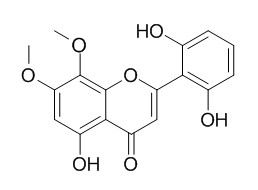Viscidulin II can be potential therapeutic agents against P. acnes-induced skin inflammation, it can significantly suppress P. acnes-induced IL-8 and IL-1β production in THP-1 cells, concomitant intradermal injection of viscidulin II with P. acnes can effectively attenuate P. acnes-induced ear swelling, and decrease the production of IL-6 and tumor necrosis factor-α in ear homogenates.
Providing storage is as stated on the product vial and the vial is kept tightly sealed, the product can be stored for up to
24 months(2-8C).
Wherever possible, you should prepare and use solutions on the same day. However, if you need to make up stock solutions in advance, we recommend that you store the solution as aliquots in tightly sealed vials at -20C. Generally, these will be useable for up to two weeks. Before use, and prior to opening the vial we recommend that you allow your product to equilibrate to room temperature for at least 1 hour.
Need more advice on solubility, usage and handling? Please email to: service@chemfaces.com
The packaging of the product may have turned upside down during transportation, resulting in the natural compounds adhering to the neck or cap of the vial. take the vial out of its packaging and gently shake to let the compounds fall to the bottom of the vial. for liquid products, centrifuge at 200-500 RPM to gather the liquid at the bottom of the vial. try to avoid loss or contamination during handling.
Molecules, 2015, 21(1):E15.
Flavones Isolated from Scutellariae radix Suppress Propionibacterium Acnes-Induced Cytokine Production In Vitro and In Vivo.[Pubmed:
26712724 ]
Scutellariae radix, the root of Scutellaria baicalensis, has long been applied in traditional formulations and modern herbal medications. Propionibacterium acnes (P. acnes) in follicles can trigger inflammation and lead to the symptom of inflammatory acnes vulgaris.
METHODS AND RESULTS:
This study was aimed at evaluating the effect of Scutellariae radix extract and purified components isolated from it on inflammation induced by P. acnes in vitro and in vivo. The results showed the ethyl acetate (EA) soluble fraction from the partition of crude ethanolic extract from Scutellariae radix inhibited P. acnes-induced interleukin IL-8 and IL-1β production in human monocytic THP-1 cells. Seven flavones were isolated from the EA fraction by repeated chromatographies, and identified as 5,7-dihydroxy-6-methoxyflavone (FL1, oroxylin), 5,7-dihydroxy-8-methoxyflavone (FL2, wogonin), 5-hydroxy-7,8-dimethoxyflavone (FL3, 7-O-methylwogonin), 5,6'-dihydroxy-6,7,8,2'-tetramethoxy flavone (FL4, skullcapflavone II), 5,7,4'-trihydroxy-8-methoxyflavone (FL5), 5,2',6'-trihydroxy-7,8-dimethoxyflavone (FL6, Viscidulin II), and 5,7,2',5'-tetrahydroxy-8,6'-dimethoxyflavone (FL7, ganhuangenin). They all significantly suppressed P. acnes-induced IL-8 and IL-1β production in THP-1 cells, and FL2 exerted the strongest effect with half maximal inhibition (IC50) values of 8.7 and 4.9 μM, respectively. Concomitant intradermal injection of each of the seven flavones (20 μg) with P. acnes effectively attenuated P. acnes-induced ear swelling, and decreased the production of IL-6 and tumor necrosis factor-α in ear homogenates.
CONCLUSIONS:
Our results suggested that all the seven flavones can be potential therapeutic agents against P. acnes-induced skin inflammation.



